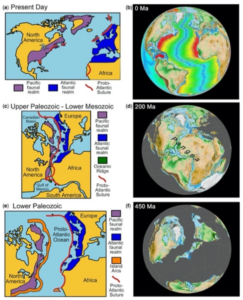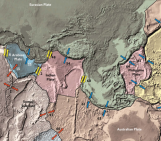
J.T. Wilson published “Did the Atlantic close and reopen?” in 1966, giving birth to the so called “Wilson Cycle”. The article is a key steppingstone for the theory of plate tectonics, and it is a must-read paper not only in tectonics studies but also in paleontology and stratigraphy.
The questions raised can be generally abridged in two: “Why regions with similar fauna can be very far from each other? Why other regions with dissimilar fauna are next to each other?” The answer to the first anomaly was already solved by Grabau (1936) and the postulation of the Mesozoic drifting of the North Atlantic. Wilson (1966) sets to prove that also the second question could be explained with an older, Lower Paleozoic drifting. Wilson envisaged the presence of a Lower Paleozoic ocean (proto-Atlantic Ocean), responsible for the two separate fauna realms (Pacific and Atlantic).

Fig. 1: comparison of Wilson 1966 reconstructed map for the North Atlantic (a,c,e) with
modern day example using Gplates (b,d,f). (Picture from Wilson et al., 2019)
The proto-Atlantic Ocean started to close from Middle Ordovician and by Early Mesozoic no deep Ocean existed anymore. Since the Upper Ordovician the fauna was very homogeneous. The Atlantic Ocean started “re-opening” in the Lower Cretaceous not precisely following the line of junction formed during the closure. This caused the transposition of some coastal regions from the east to the west side and vice versa, that allows to preserve on the same Atlantic side two different antecedent realms. In the paper, then, a series of observations made mainly on the fossil fauna, rock sequences and fault zones from previous studies, have been commented in order to define the position of the proto-Atlantic Ocean and the separation between the two fauna realms (Fig. 1). At that time, geologists believed that differences in fossil fauna could be better explained by the presence of different environments, instead of the drift of Atlantic Ocean. However, Wilson sustained that this was only possible inside the same fauna realm.
The absence of an abstract -even if the main results already appear in a very clear and concise way at the beginning of the paper- and the presence of direct quotes and several “personal communication” underline the evolution of the style of scientific papers since 1966. On the reddit platform discussion, Gianluca Frasca highlighted the importance of paleontology in the development of the theory of plate tectonics. However, he regrets the fact that Wilson did not deal with “cycle” evidences from the southern hemisphere.
The article ends suggesting to test the consequences of the opening of the Atlantic, today recognized as the Cretaceous superplume, as well as to consider the Hercynian orogeny and faulting and post-Triassic faulting.
This paper completely changed the prospective of continental drift theory and led to the introduction of the Wilson Cycle concept: opening by extensional processes and closure by subduction of oceanic basins. This concept is in continuous evolution thanks to advances in technology (AI, big data) and improved knowledge about lithosphere mechanics and plate kinematics.
Written by Marta Marchegiano, Benoît Petri, Gianluca Frasca and the TS Must-Read Team
References
Grabau A.W. (1936). Paleozoic Formations in the Light of the Pulsation Theory, 1 (University
Press, National University of Peking)
Wilson J.T. (1966). Did the Atlantic close and re-open? Nature, 211, 676-681
Wilson R.W., Houseman G.A., Buiter, S.J.H., McCaffrey K.J.W. and Doré A.G. (2019). Fifty
years of the Wilson Cycle concept in the plate tectonics: an overview. Geological Society,
London, Special Publications, 470, 1-17


